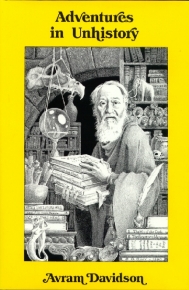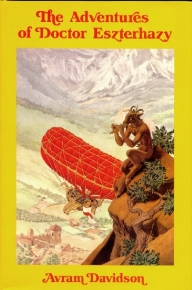

 Cover by Drive Communictions 0-312-86729-8447pp/$27.95/October 1998 |
THE AVRAM DAVIDSON TREASURY&THE INVESTIGATIONS OF AVRAM DAVIDSONby Avram DavidsonTor & St Martin's |
0-312-86518-X384pp/$24.95/February 1999 |
 Cover
by George Barr Cover
by George Barr0-913896-29-2307pp/$24.75/1993 |
ADVENTURES IN UNHISTORY&THE ADVENTURES OF DOCTOR ESZTERHAZYby Avram DavidsonOwlswick Press |
 Cover by George Barr 0-913896-28-4366pp/$24.50/1990 |
Reviewed by Steven H Silver
Avram Davidson may have been one of the most unstereotypical science fiction and fantasy authors ever to grace the pages of the magazines. An orthodox Jew for much of his life, Davidson's earliest pieces were published in the Yiddish press, he served in the United States Navy for the duration of World War II and then with the Israeli Forces following the declaration of the state of Israel in 1948. His first published story in English appeared in Fantasy and Science Fiction in 1954, "My Boyfriend's Name is Jell-O." This is also the first story to appear in The Avram Davidson Treasury, a retrospective of Davidson's writing career.
Davidson's writing could, at times, be very inaccessible, and "My Boyfriend's Name is Jell-O," which is a stream-of-conscious tale based on children's jump-rope rhymes, may be off-putting to many readers unfamiliar with Davidson's amazing narrative skills. For those who haven't read much of his work, it is highly recommended to delve deeper into this collection for a starting point, for instance, "The Golem," about a retired couple who must deal with a golem intent on their destruction, or "Help! I Am Dr. Morris Goldpepper," which demonstrates Davidson's often wry sense of humor as a dentist saves the Earth from invasion.
Wherever the reader begins, what becomes evident very quickly is Davidson's erudition. Although Davidson never managed to graduate college, he demonstrates himself to be a font of arcane knowledge, dropping references and allusions right and left, simply assuming that his readers will understand him. His skill is such, that frequently the reader can pick up whatever they need from the context.
The same can be said of his choice of words. There are some authors who are known for their use of uncommon words (Gene Wolfe, Stephen R. Donaldson). In their number must be included Avram Davidson. His word choice, however odd, is always done to evoke a mood, and he is adept enough that even when the reader may not know exactly what the word means, it still, somehow, manages to bring about the proper sensation.
When Grania Davis, Davidson's ex-wife, and Robert Silverberg began compiling The Avram Davidson Treasury, they did so by going through Davidson's phone book and asking his friends to select their favorite stories and write introductions. The resulting book includes commentary on stories, reminiscences of Davidson, and just general comments by such luminaries as Harlan Ellison, Ray Bradbury, Frederik Pohl, Ursula K. LeGuin, Wolfe, and 35 others.
Not all of Davidson's stories work. The aforementioned "My Boyfriend's Name is Jell-O" and "The Tail-Tied Kings" are examples in which the writing is convoluted. However, these are far outweighed by such masterpieces as "Now Let Us Sleep" and "Or the Grasses Grow" about oppression, or "Ogre in the Vly" about professional ethics.
Some of the strongest stories in The Avram Davidson Treasury are not the science fiction or fantasy stories, but rather the mysteries or mainstream tales. Foremost among these is "The Affair in Lahore Cantonment," a bar tale which harkens back to Rudyard Kipling's India as seen in The Just So Stories and Kim.
For those who enjoy Davidson's non-fantastic tales, St. Martin's Press has recently published another collection of Davidson's writings, The Investigations of Avram Davidson. This collection includes thirteen of Davidson's mysteries, with minimal overlap with The Avram Davidson Treasury (only the excellent examination of slavery, "The Necessity of His Condition" appears in both).
Davidson’s investigations are anything but routine murder mysteries. Instead, they deal with the people and motives who are involved. "The Ikon of Elijah," about a corrupt antique dealer on Cyprus, questions our ideas about punishment when the dealer is subjected to something he views as incarceration, but which his jailers may very well see as a reward. The issue of punishment is also brought up in the "The Cost of Kent Croswell." When a disliked man moves to the outskirts of the town, the village officials must bend to meet his will. By staying within the law, they rack up tremendous bills which the town can ill afford, especially since Croswell is more than happy to remain in jail, housed and fed at taxpayer expense, rather than be sent home or pay a fine. In this reversal of "The Ikon of Elijah," Davidson is addressing the same question of how effective imprisonment is as a punishment.
The mysteries in The Investigations of Avram Davidson are sure to whet the reader’s appetite for more of his mysteries. Unfortunately, the reader will have to haunt used bookstores in order to find his mystery novels or magazines that have the individual stories. On the other hand, some of the few Davidson books still in print have elements of mystery in them.
The Adventures of Doctor Eszterhazy was published shortly before Davidson’s death. This book, which is an expansion from the earlier The Enquiries of Doctor Eszterhazy, follows the history of Eszterhazy in his fictional kingdom of Scythia-Pannonia-Transbalkania during the reign of Emperor Ignats Louis. The stories cover a period from Engelbert Eszterhazy's youth when he worked as an equerry in the story "Cornet Eszterhazy" through his several degrees until "The King's Shadow Has No Limits." These stories, which could be considered fantasy, tend to borrow as much from Sherlock Holmes and The Prisoner of Zenda as they do from standard fantasy texts.
These stories are very different from many of those that appear in The Avram Davidson Treasury and all of the stories from The Investigations of Avram Davidson. With Doctor Eszterhazy, Davidson truly felt he was able to stretch his vocabulary and highlight his knowledge. The language in which these tales are written flows, but it is also more flowery than the language Davidson frequently used.
In these tales, Davidson brings together the ideas of magic and religious power and combines them with Eszterhazy, who is trying to codify and understand the world around him using the latest scientific advances. Eszterhazy does not believe in Occam’s Razor. Neither, for him, is Sherlock Holmes’s favorite dictum that once you remove the impossible, whatever remains, however implausible, must be the case. In Eszterhazy’s world, the impossible is possible, as long as Davidson can conceive of a rational explanation.
The collection also includes a nicely written explanation by Davidson of where the idea for Dr. Eszterhazy came from, along with some background information about Davidson’s choice of nomenclature and some of the private jokes that he decided to include. Although not necessary for the enjoyment of the book, the afterword presents other aspects of the stories that aren’t immediately apparent.
Finally, Davidson also turned his attention to the world around us. His final collection while living was Adventures in Unhistory, a mixture of fact and fantasy. In these essays, Davidson set his sights on legends and mythology and tries to explain the basis for the various legends. Although done in a chatty style, it is an highly educated chatty style. Davidson frequently goes off on rambling tangents, but always manages to tie his strange information back to the main point.
In these essays Davidson tackles such diverse topics as the origins of the legends of the Phoenix and the appearance of dragons in so many different cultures. He also looks at more historical questions, such as the identity of Prestor John, a Christian ruler in Asia in the twelfth century, who sent letters to the Byzantine Emperor, Holy Roman Emperor, and the Pope and then vanished. Simply suggesting that people made up clever stories isn’t enough for Davidson, he wants to try to figure out how the stories originated.
If The Adventures of Doctor Eszterhazy demonstrated Davidson’s skill with words, then Adventures in Unhistory demonstrates Davidson’s skill with research and words. What could have become dry essays instead become riveting detective stories in which historical theory and fact become the fugitives Davidson is trying to track down.
It is indicative of how good an author Davidson is that after reading nearly 1400 pages of his writing, I am looking forward to reading his Nebula nominated novella, The Boss in the Wall, in the near future. The stories collected in The Avram Davidson Treasury, The Investigations of Avram Davidson and The Adventures of Doctor Eszterhazy underscore how much this author needs to have an editor who will champion a "Complete Works of Avram Davidson" project along the lines of the five-volume "Complete Short Stories of Phillip K. Dick" published by Citadel or the ten-volume "Complete Short Stories of Theodore Sturgeon" being published by North Atlantic Press.
| The Avram Davidson Treasury | The Investigations of Avram Davidson | The Adventures of Doctor Eszterhazy | Adventures in Unhistory |
| My Boyfriend's Name is Jello | The Necessity of His Condition | Cornet Eszterhazy | Where Did Sindbad Sail? |
| The Golem | Thou Still Unravished Bride | The Autog ndola Invention | Who Fired the Phoenix? |
| The Necessity of His Condition | The Cost of Kent Castwell | Duke Pasquale's Ring | An Abundance of Dragons |
| Help! I Am Dr. Morris Goldpepper | The Ikon of Elijah | Writ in Water, or, the Gingerbread Man | Who Makes the Mandrakes? |
| Now Let Us Sleep | The Cobblestones of Saratoga Street | The King Across the Mountains | The Boy Who Cried Werewolf |
| Or the Grasses Grow | Captain Pasharooney | Polly Charms, the Sleeping Woman | The Great Rough Beast |
| Or All the Seas with Oysters | The Third Sacred Well of the Temple | The Crown Jewels of Jerusalem, or The Tell-Tale Head | Postscript on Prester John |
| Take Wooden Indians | The Lord of Central Park | The Old Woman Who Lived with a Bear | The Theft of the Mulberry Tree |
| Author, Author | Murder is Murder | The Church of Saint Satan and Pandaemons | The Secret of Hyperborea |
| Dagon | The Deed of the Deft-Footed Dragon | Milord Sir Smiht, the English Wizard | Heads I Win, Heads You Lose |
| Ogre in the Vly | A Quiet Room with a View | The Case of the Mother-in-Law Pearl | The Spoor of the Unicorn |
| The Woman Who Thought She Could Read | Mr. Folsom Feels Fine | The Ceaseless Stone | What Gave All Those Mammoths Cold Feet? |
| Where Do You Live, Queen Esther | The Importance of Trifles | The King's Shadow Has No Limits | Bird Thou Wert, but Art No More |
| The Sources of the Nile | The Moon | ||
| The Affair at Lahore Cantonment | The Prevalence of Mermaids | ||
| Revolver | |||
| The Tail-Tied Kings | The Price of Charms; or, The Lineaments of Gratified Desire | Sacheverell | The House the Blakeneys Built |
| The Goobers | The Power of Every Root | Selectra Six-Ten | Polly Charms, the Sleeping Woman |
| And Don't Forget the One Red Rose | Crazy Old Lady | "Hark! Was That the Sound of an Angry Thoat?" | Manatee Gal, Won't You Come Out Tonight |
| Naples | Full Chicken Richness | The Hills Behind Hollywood High | The Slovo Stove |
| Revenge of the Cat-Lady | The Last Wizard | While You're Up | The Spook-Box of Theobald Delafont De Brooks |
| Yellow Rome; or, Vergil and the Vestal Virgin | |||
